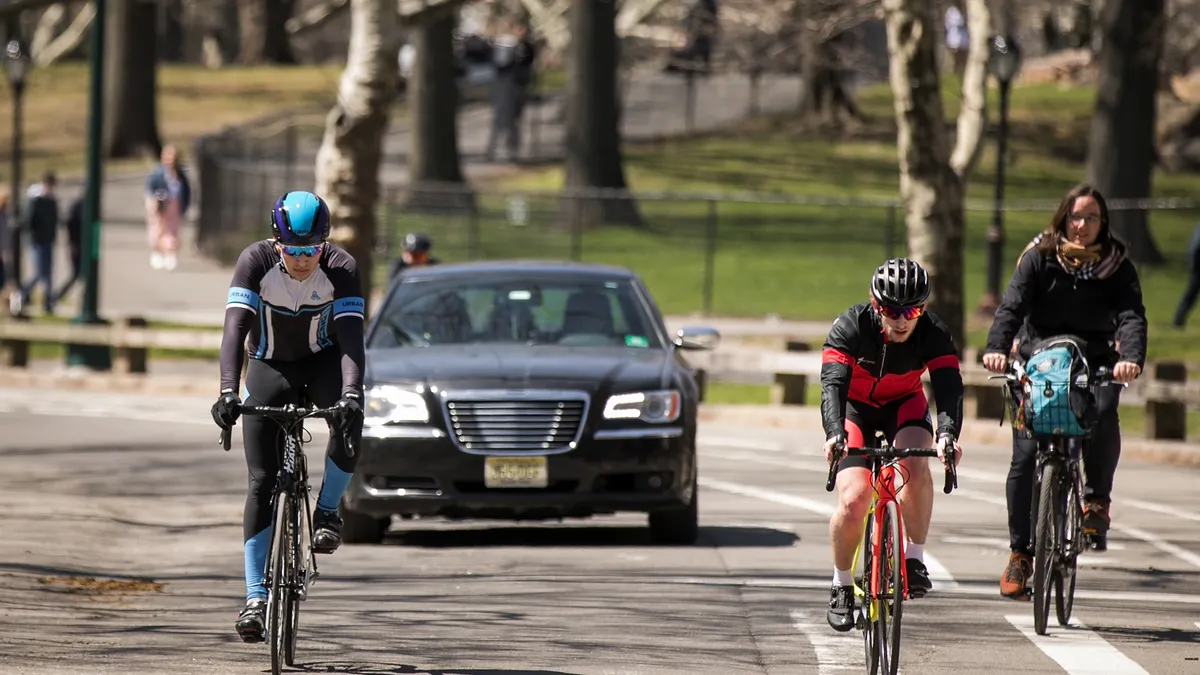Dive Brief:
- In response to sharply rising traffic fatalities, the Federal Highway Administration (FHWA) released its plan to encourage the adoption of Complete Streets design and policies among state and local authorities.
- The $1.2 trillion bipartisan infrastructure law requires states and metropolitan planning organizations to devote at least 2.5% of their planning funding to providing safe and accessible transportation options for Complete Streets activities including pedestrian, bicycle, in-vehicle or public transportation.
- The FHWA said that Complete Streets would become its "default approach for funding and designing non-access-controlled roadways," spurring resistance among some members of Congress.
Dive Insight:
More than a third of those who died in traffic accidents in 2019 were not riding in a car, truck or bus. They were pedestrians, bicyclists, motorcyclists and other roadway users. More than 6,500 pedestrians were killed in 2020, the highest number since 1989, and bicyclist fatalities rose 9.2% to a high not seen since 1987.
The FHWA Complete Streets program adopted the safe system approach outlined in the National Roadway Safety Strategy released in January by the U.S. Department of Transportation. That approach incorporates human, vehicle and roadway factors in an effort to reduce serious injuries and fatalities.
"FHWA has done an excellent job in clearly laying out and describing the actions that are needed throughout the entire federal transportation program to truly build safe streets and roads for all people, including getting better safety data, assessing safety in project development and making safety the primary goal and Complete Streets the default design," said Beth Osborne, vice president of transportation at Smart Growth America, in a statement emailed to Smart Cities Dive.
But some of the Biden administration's guidance on the implementation of the infrastructure law is getting pushback. In a letter to White House Infrastructure Coordinator Mitch Landrieu last week, House Committee on Transportation and Infrastructure Ranking Member Rep. Sam Graves, R-MO, and House Committee on Oversight and Reform Ranking Member Rep. James Comer, R-KY, wrote, "This massive spending bill … leaves the door open for the Administration to pursue their 'woke' priorities rather than allocating the funds based on states’ actual needs."
Also, Senate Republicans Mitch McConnell and Shelley Moore Capito sent a letter to governors in February stating, "Nothing in the IIJA provides FHWA with the authority to dictate how states should use their federal formula funding, nor prioritizes public transit or bike paths over new roads and bridges."
But Tara Gill, senior director of advocacy and state legislation at Advocates for Highway and Auto Safety, said that the FHWA report is just at the beginning of the process and that the agency is aware of the needs and constraints of individual states and local governments.
Local opposition has come into play in some areas as well over street closures for non-automotive uses. In San Francisco, a contentious battle has played out over the closure of JFK Drive to cars through Golden Gate Park. Two museums in the park, along with park-goers with disabilities, have fought plans to make the closure permanent. Another road, the Great Highway between Lincoln Way and Sloat Boulevard, has been closed to vehicles on weekends and is the subject of a lawsuit filed by a group of local residents and commuters who use the road.
Still, according to Smart Growth America, more than 1,600 Complete Streets policies have been enacted in the United States, including 35 state governments. "It's not like this is starting from ground zero," said Gill. "This is already happening across the U.S."
The FHWA acknowledges a number of challenges it faces to advance Complete Streets programs. These include, among others:
- Incomplete pedestrian and bicycle network data;
- States and cities giving priority to reducing traffic congestion, "which can conflict with the goal of providing safe facilities for all users;"
- State and local laws that may limit the use of federal funding at the local level.
Nevertheless, many easily-implemented measures can have a dramatic impact on roadway safety, according to the FHWA. Better lighting at intersections can reduce nighttime accidents with pedestrians by 42%; center-line rumble streets cut fatal head-on collisions on two-lane rural roads by 44% to 64%; replacing a two-way intersection with a roundabout reduces fatal crashes by 82%; and adding a bike lane can reduce the total number of crashes by up to 49% on certain roads.
The FHWA report outlined four next steps the highway administration will pursue:
- Making it easier for state and local agencies to advance and build Complete Streets projects by reassessing FHWA policies and procedures;
- Providing leadership, technical assistance, peer learning and other support to local and state agencies;
- Improving data collection and developing performance measures;
- Expeditiously implementing new Complete Streets program eligibilities and other provisions in the bipartisan infrastructure law.
"The consecutive increases in traffic fatalities are just out of control on our roads," said Gill, adding that pedestrian and bicycle deaths have soared. "Taking a bike ride or a walk should not be a death-defying act."












